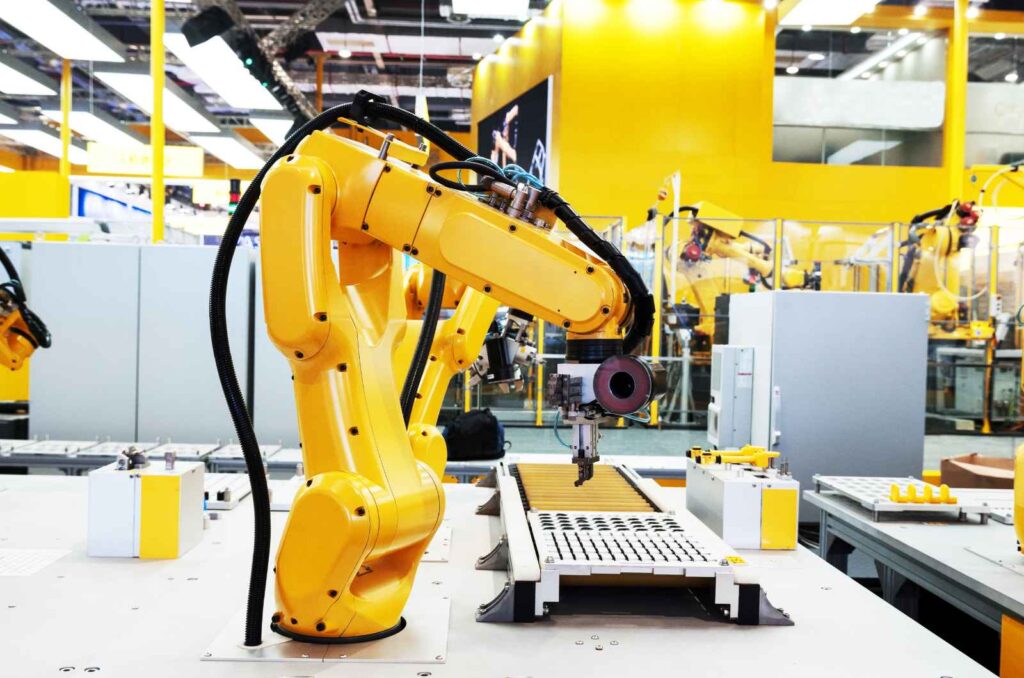
Smart robotic cells represent the next generation of industrial automation, combining artificial intelligence, advanced sensors, and self-learning capabilities to create autonomous manufacturing environments. These systems enable manufacturers to increase productivity by up to three times, improve product quality, and adapt production to changing demands in real time. In 2025, North American manufacturers ordered over 9,000 new industrial robots in the first quarter alone, valued at approximately $580 million, with the automotive industry leading with a 42% increase in units and 78% increase in value compared to the previous year. This shift reflects a global trend toward smarter and more efficient manufacturing.
?What Are Smart Robotic Cells and Why Are They Critical
A smart robotic cell is an autonomous workspace that integrates one or more industrial robots with advanced peripheral equipment, intelligent control systems, sensors, and real-time data processing capabilities. Unlike traditional robotic cells that perform a fixed sequence of operations, smart cells can learn, adapt, and make decisions independently. Vision systems enable robots to identify parts, perform quality inspections, and adjust their operations to different products without complex reprogramming. Advanced safety sensors such as light curtains and laser scanners protect workers while maintaining optimal operating speeds. These systems are particularly critical in high-mix manufacturing, where a wide variety of products must be produced on identical production lines.
How Does Artificial Intelligence Make Manufacturing Cells More Autonomous
The integration of artificial intelligence and machine learning in robotic cells represents a fundamental shift in automation capabilities. AI systems enable robots to perform real-time motion planning, avoid collisions, and autonomously select the most efficient work path. AI-based quality control systems can detect defects with over 98% accuracy, far exceeding human inspection capabilities. Research published by the Association for the Advancement of Artificial Intelligence in 2025 indicates that robotic cells powered by embedded AI enable the production of a wide variety of products without extensive manual programming. This adaptability makes manufacturing more flexible and dramatically reduces changeover time between different products, which was previously one of the main challenges in industrial manufacturing.
Can Collaborative Robots Work Alongside Human Workers
Collaborative robots, also known as cobots, are specifically designed for safe operation alongside human workers without requiring physical barriers. In 2025, cobots represent 11.6% of all industrial robots ordered in North America, with adoption rates exceeding 20% in certain industries such as life sciences and food processing. Cobots are equipped with force and torque sensors that limit their operational strength upon unexpected contact, and vision systems that enable them to detect human presence and adjust their behavior accordingly. Human-machine collaboration allows factories to leverage the advantages of both worlds: the precision and consistency of robots alongside the flexibility and problem-solving ability of humans. Studies show this combination can increase productivity by approximately 30% while maintaining maximum factory safety.
What Are the Main Benefits of Robotic Cells in Modern Manufacturing
Smart robotic cells offer a wide range of benefits that make them essential in modern industrial manufacturing. First, they enable significant productivity increases through continuous 24/7 operation without breaks and higher execution speed of repetitive tasks. Second, these cells ensure consistent quality and high precision in every production cycle, significantly reducing defect rates and rework requirements. Third, they improve factory safety by performing hazardous tasks instead of workers, leading to a 60-75% reduction in repetitive stress injuries and workplace accidents. Fourth, robotic cells reduce long-term operating costs through reduced labor requirements for repetitive tasks and minimization of material waste. Finally, the modular and flexible design of cells enables rapid adaptation to demand changes and new products, a capability that has become critical in 2025's rapidly changing market.
How Do Vision Systems Improve Cell Accuracy
Vision systems serve as the eyes of smart robotic cells and enable them to perceive their work environment with great precision. Advanced 3D systems can identify parts with millimeter-level accuracy, verify their presence and orientation before performing operations, and conduct complex quality inspections in real time. These technologies incorporate deep learning algorithms that enable robots to learn and improve their performance over time. Fifty percent of manufacturers already rely on AI-driven insights for quality control in 2025, with these systems detecting defects, surface cracks, and welding anomalies at accuracy levels far exceeding any human inspection. This capability not only increases the percentage of conforming products but also significantly reduces costs associated with detecting defects late in the production chain.
Why Are Companies Moving to Edge Computing and Cloud-Based Cells
Connecting robotic cells to the Industrial Internet of Things and cloud technologies represents a critical step in creating truly smart manufacturing environments. Edge computing enables cells to process information locally and immediately, which is essential for tasks requiring real-time response such as motion planning and collision avoidance. Simultaneously, cloud connectivity provides advanced data analytics capabilities, historical storage, and the ability to remotely manage systems. Data indicates that by the end of 2025, 75% of enterprise data will be processed on edge servers or local computing devices, a dramatic increase from just 10% in 2018. This integration enables predictive maintenance by analyzing operational patterns and identifying anomalies before they become failures, significantly reducing unplanned downtime and increasing overall production line efficiency. Manufacturers implementing these technologies report 15-20% improvements in production speed and approximately 40% reduction in maintenance costs.
How Assatec Robotics Leads the Robotic Revolution in Israel
With over 28 years of experience since its founding in 1997, assatec Robotics has established itself as the leader in advanced robotic cells and automation in Israel. The company specializes in designing and implementing customized robotic cells that integrate the most advanced technologies from FANUC, one of the world's leading manufacturers. Assatec's unique approach focuses on turnkey solutions that accompany clients from the design stage through ongoing support, with precise adaptation to each factory's specific needs. The company has built more robotic systems than any other entity in the country and serves a wide range of industries from automotive and electronics to food and pharmaceutical industries. Strategic partnerships with leading companies such as OnRobot, which specializes in tools for collaborative robots, and A-feeders, which provides advanced feeding solutions, enable Assatec to offer comprehensive and integrated solutions. The company's full parts inventories and expert technical support ensure high system availability and rapid response to any technical issue.
What Are the Risks and Challenges in Implementing Robotic Cells
Despite the many advantages, implementing robotic cells comes with challenges that must be addressed intelligently. The first challenge is the high initial investment, which can reach tens of thousands of dollars or more for complex systems, though this investment typically pays for itself within two to three years through operational cost savings. The second challenge is the need for skilled personnel capable of programming, operating, and maintaining advanced systems, with 87% of companies identifying skills shortages as the main challenge in automation implementation. The third challenge relates to integration with existing systems and the need to adapt work processes, which requires careful planning and sometimes infrastructure changes. The fourth challenge concerns cybersecurity, with over 40,000 industrial control systems in the United States exposed to potential attacks on critical infrastructure. Successfully addressing these challenges requires collaboration with experienced integrators like Assatec, who provide professional guidance throughout the implementation process and ensure appropriate training for work teams.
When Should You Consider Moving to Smart Robotic Automation
The decision to move to smart robotic cells should be based on clear business and operational considerations. Robotic cells are particularly suitable for factories performing repetitive tasks in large quantities, such as assembly, welding, packaging, or material handling. They are also ideal for processes requiring very high precision or that endanger worker health. Factories dealing with skilled labor shortages or high labor costs will find automation a direct solution to these problems. It's important to conduct a detailed return on investment analysis that examines costs versus expected savings, considering not only labor costs but also quality improvement, waste reduction, and throughput increase. Factories wanting to remain competitive in the modern market should consider automation when planning expansion, when required to significantly improve quality, or when anticipating significant changes in product demand. Especially in 2025, when 63% of manufacturers use technology to automate additional tasks and another 30% plan to implement more software automation, adopting these technologies becomes a critical competitive advantage.
Smart robotic cells represent the future of industrial manufacturing, combining advanced technologies of artificial intelligence, smart sensors, and autonomous capabilities to create efficient and precise production environments. These systems enable factories to dramatically increase productivity, improve product quality, reduce operating costs, and flexibly adapt production to market changes. In Israel, leading companies like Assatec Robotics continue to innovate and provide advanced solutions tailored to local needs while leveraging the latest technologies from around the world. Despite challenges related to initial investment and the need for skilled personnel, the long-term benefits of smart robotic automation make it a necessary investment for manufacturers wanting to remain competitive in 2025's changing market and beyond. The increasing penetration of AI technologies, Edge Computing, and collaborative robots is expected only to accelerate this trend in coming years.
